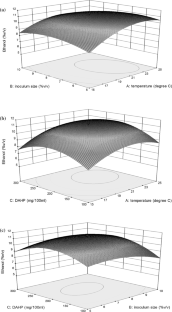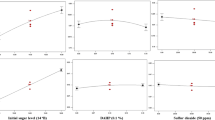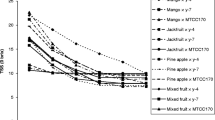Abstract
The present study was conducted to optimize fermentation parameters for apple wine production using Golden Delicious apples. Physicochemical analysis of the cultivar revealed a °Brix-acid ratio of 24.61 with ample amount of total and reducing sugars (9.6 and 6.03% w/v); making it a suitable substrate to produce ethanol. Microbiological analysis lead to isolation of a yeast strain (namely A2) which was molecularly identified and accessed at GenBank as S. cerevisiae KY069279. Ethanol fermentation optimization using response surface methodology revealed that a temperature of 20 °C, an inoculum size of 7.08 (%v/v) and diammonium hydrogen phosphate supplementation @ 154.4 mg/100 mL as optimum for apple wine production which lead to 10.73% (v/v) ethanol production with a desirability of 86.9%. Fresh wine having malic acid content of 1.87 (mg/100 mL) was subjected to malolactic fermentation (MLF) for 8 days using Leuconostoc oenos NCIM 2219 resulting in apple wine having 0.4 (mg/100 mL) malic acid. Sensory analysis of MLF and non-MLF apple wines categorised them as superior quality with average scores of 69.5 and 74.5, respectively. Gas chromatography–mass spectrometric analysis of apple wine revealed the presence of 38 volatile compounds including higher alcohols, acids, esters etc. The study thus revealed a process for apple wine preparation using an indigenous yeast and also optimized and compared malolactic and non-malolactic fermented ciders.


Similar content being viewed by others
References
Alberti A, Vieira RG, Drilleau JF, Wosiacki G, Nogueira A (2011) Apple wine processing with different nitrogen contents. Braz Arch Biol Technol 54(3):551–558
Amerine MA, Roessler EB (1976) Wines: their sensory evaluation. Freeman, San Francisco
Cabranes C, Mangas JJ, Blanco D (1997) Selection and biochemical characterisation of Saccharomyces cerevisiae and Kloeckera Apiculata strains isolated from Spanish cider. J Inst Brew 103:165–169
Campo GD, Berregi IA, Santos JI, Duen M, Irastorza A (2007) Development of alcoholic and malolactic fermentations in highly acidic and phenolic apple musts. Biores Technol 99:2857–2863
Cheema HS, Singh B (1991) Software Statistical Package CPCS-1. Developed at Department of Statistics, Punjab Agricultural University, Ludhiana
Cruz SH, Cilli EM, Ernandes JR (2002) Structural complexity of the nitrogen source and influence on the yeast growth and fermentation. J Inst Brew 108:54–61
Davis CR, Wibowo DJ, Eschenbruch R, Lee TH, Fleet GH (1985) Practical implications of malolactic fermentation: a review. Am J Enol Vitic 36:290–301
Downing DL (1989) Apple cider. In: Downing DL (ed) Processed apple products, 1st edn. Van Nostrand Reinhold, New York, pp 169–188
Dubois M, Gilles KA, Hamilton JK, Rebers PA, Smith F (1956) Colorimetric method for determination of sugars and related substances. Anal Chem 28:350–356
GenBank (2016) GenBank Submissions Handbook www.ncbi.nlm.nih.gov/books/NBK51157. Accessed 2 Nov 2016
Goodban AE, Stark JB (1957) Rapid method for determination of malic acid. Anal Chem 29:283–287
Henick-Kling T (1993) Malolactic fermentation. In: Fleet GH (ed) Wine microbiology and biotechnology, 1st edn. Harwood Academic Publishers, Switzerland, pp 289–326
Henick-Kling T, Acree TE, Krieger SA, Laurent MH, Edinger WD (1994) Modification of wine flavour by malolactic fermentation. Wine East 4:8–15
Herrero M, Garcial LA, Diaz M (2006) Volatile compounds in cider: inoculation time and fermentation temperature effects. J Inst Brew 112(3):210–214
Jarvls B, Forster MJ, Kinsella WP (1995) Factors affecting the development of cider flavour. J Appl Bacter Symp Sup 79:5S–18S
Jolicoeur C (2013) The new cider maker’s handbook: a comprehensive guide for craft producers. Chelsea Green Publishing, Hartford
Joshi VK, Attri D (2005) Panorma of research and development of wines in India. J Sci Nat Res 64:9–18
Joshi VK, Kumar V (2017) Influence of different sugar sources, nitrogen sources and inocula on the quality characteristics of apple tea wine. J Inst Brew 123(2):268–276
Kahle K, Kraus M, Richling E (2005) Polyphenol profiles of apple juices. Mol Nut Food Res 49:797–806
Laurent MH, Henick-Kling T, Acree T (1994) Changes in the aroma and odor of Chardonnay wine due to malolactic fermentation. Wein Wissenschaft 49:3–10
Liu SQ (2002) Malolactic fermentation in wine- beyond deacidification: a review. J Appl Microbiol 92:589–601
Lorrenzini M, Zapparoli G (2019) Assessment of yeasts for apple juice fermentation and production of cider volatile compounds. LWT Food Sci Tech 99:224–230
Malik CB, Singh MB (1991) Plant enzymology and histoenzymology. Kalyani Publishers, New Delhi, pp 274–279
Miller GL (1959) Use of Dinitrosalicylic acid reagent for determination of reducing sugar. Anal Chem 31:426–428
Musyimi SM, Sila DN, Okoth EM, Onyango CA, Mathooko FM (2013) The influence of process optimization on the fermentation profile of mango wine prepared from the Apple mango variety. J Animal Plant Sci 17(3):2600–2607
NHB (2015) World Wide Web source for National Horticulture Board data. http://nhb.gov.in/area-pro/NHB_Database_2015.pdf. Published 11 Feb 2015. Accessed 5 Apr 2016
Nikhanj P, Kocher GS, Boora RS (2017) Fermentative production of guava wine from pectinase treated and untreated juice of ‘punjab pink’ cultivar of Psidium guajava L. Agric Res J 54(2):244–247
Novak A, Wilk MK, Pogorzelski E, Czyowska A (2013) Effect of nitrogen sources on fermentation process and formation of H2S and ethyl carbamate by wine yeast. Biotech Food Sci 77(1):11–23
Oyeleke O (2007) Extraction of juice from some tropical fruits using a small scale fruit-juice extractor. Afr Crop Sci 8:1803–1808
Peng B, Lei Y, Zhao H, Cui L (2015) Response surface methodology for optimization of fermentation process parameters for improving apple wine quality. J Food Sci Technol 52(11):7513–7518
Polshettiwar SA, Ganjiwale RO (2007) Spectrophotometric estimation of total tennins in some ayurvedic eye drops. Ind J Pharm Sci 69(4):574–576
Pooja (2016) Optimization of enological practices for production of quality wines from grapes. Ph.D., Dissertation. Punjab Agricultural University, Ludhiana, India
Santos JP, Arroyo T, Aleixandre M, Lozano J, Sayago I, García M, Fernándeza MJ, Arésa L, Gutiérreza J, Cabellosb JM, Gilb M, Horrilloa MC (2004) A comparative study of sensor array and GC–MS: application to Madrid wines characterization. Sens Actuators B Chem 102:299–307
Sauvageot F, Vivier P (1997) Effects of malolactic fermentation on sensory properties of four Burgundy wines. Am J Enol Vitic 48(2):187–192
Shankar S, Babu JD, Reddy YN (2006) Fermentation of guava pulp with grape grown yeast (Saccharomyces cerevisiae var. ellipsoideus) for wine production. Ind J Hort 63(2):171–173
Sukhvir (2016) Evaluation of apple cultivars for fermentative production of cider. M.Sc. thesis, Punjab Agricultural University, Ludhiana, India
Volschenk H, Van Vuuren H, Viljoen-Bloom M (2006) Malic acid in wine: origin, function and metabolism during vinification. S Afr J Enol Vitic 27(2):123–136
Wang D, Xu Y, Hu J, Zhao G (2004) Fermentation kinetics of different sugars by Apple wine Yeast Saccharomyces cerevisiae. J Inst Brew 110:340–346
Williams AA (1974) Flavour research and the cider industry. J Inst Brew 80:455–470
Zhao H, Zhou F, Dziugan P, Yao Y, Zhang J, Lv Z, Zhang B (2014) Development of organic acids and volatile compounds in cider during malolactic fermentation. Czech J Food Sci 32:69–76
Author information
Authors and Affiliations
Corresponding author
Additional information
Publisher's Note
Springer Nature remains neutral with regard to jurisdictional claims in published maps and institutional affiliations.
Rights and permissions
About this article
Cite this article
Sukhvir, S., Kocher, G.S. Development of apple wine from Golden Delicious cultivar using a local yeast isolate. J Food Sci Technol 56, 2959–2969 (2019). https://doi.org/10.1007/s13197-019-03771-0
Revised:
Accepted:
Published:
Issue Date:
DOI: https://doi.org/10.1007/s13197-019-03771-0




